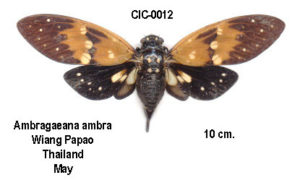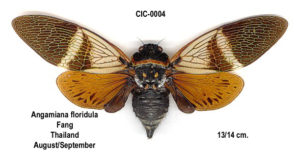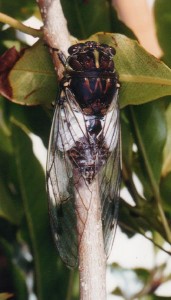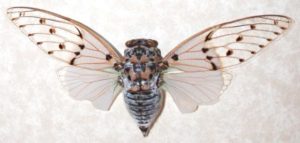C is for Cicada Killer Wasp. The Cicada Killer Wasp (in North America, Sphecius speciosus) is a large wasp, which captures adult cicadas, paralyzes them, places them in a burrow, and then lays an egg on them. The cicada dies as it is consumed by the developing wasp larvae. If you want to learn more about these wasps, visit Prof. Chuck Holiday’s Cicada Killer Wasp Website.
As you might guess from Elias Bonaros’ photo, Cicada Killer Wasps are less aggressive towards humans than other wasps, however, we do not recommend approaching them, particularly, if you are a cicada.
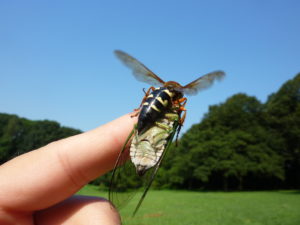
More (lots more):
Cacama valvata is a species of cicada found in the South-Western United States.
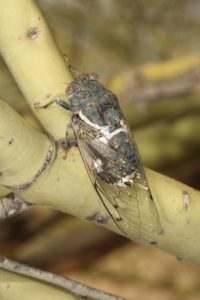
Cacama valvata photo by Adam Fleishman.
The Canadian Cicada, aka Okanagana canadensis, is a species of cicada found in Canada.
The Carineta diardi is arguably the most beautiful cicada of all. C. diardi exist in Brazil. Their black, red, green bodies and yellow tinted wings are amazing to behold.
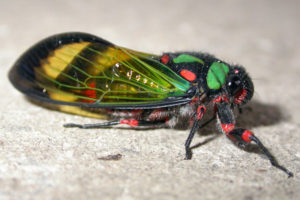
Photo by Pia Öberg.
A chimney (aka a turret) is a chimney-like structure that a cicada builds above the hole it will emerge from when it’s ready to become an adult. Cicada researchers look for chimneys to get an idea where cicadas will emerge.

Cicadetta calliope (formerly Melampsalta calliope) is a species of cicada found in the South-Eastern United States. It is rust-orange and black, and its eyes are a pretty rose color.
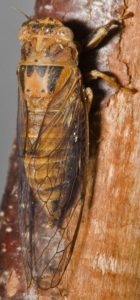
Photo by Paul Krombholz.
The clypeus is that bulbous structure on the cicada’s head that looks like it could be the cicada’s nose or the grill of a 1950’s automobile. The clypeus holds the muscles the cicada uses to pump plant fluids through its needle-like beak and to its digestive system. Clypeus means shield in Latin.

John Cooley is one of the premier cicada researchers working today. Visit John’s site Cicadas @ UCONN (formerly Magicicada.org), which is dedicated to re-mapping the location of Magicicada broods.
The cruciform elevation is a cross-shaped structure on the dorsal posterior portion of a cicada’s thorax:

Cryptotympana is a genius of cicadas which exist in Asian countries like Thailand. 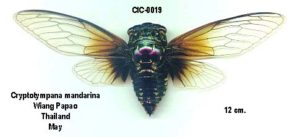
Photo by Michel Chantraine.



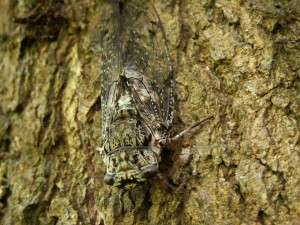
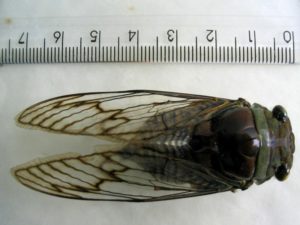
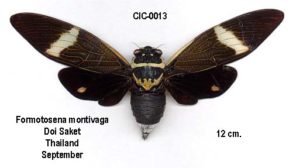
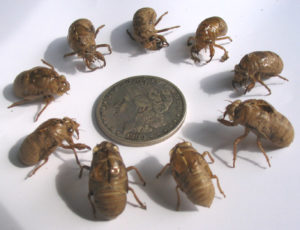









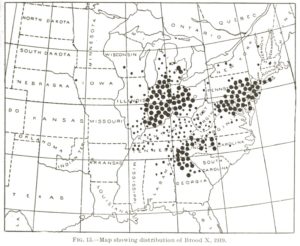 Magicicada cicadas are American periodical cicadas that have 17 or 13 year life cycles. There are 12 groups of Magicicadas with 17 year life cycles, and 3 groups of Magicicadas with 13 year life cycles. Each of these groups emerge in a specific series of years, rarely overlapping (17 year groups co-emerge every 289 years). Each of these groups emerge in the same geographic area their parents emerged. These groups, each assigned a specific Roman numeral, are called broods.
Magicicada cicadas are American periodical cicadas that have 17 or 13 year life cycles. There are 12 groups of Magicicadas with 17 year life cycles, and 3 groups of Magicicadas with 13 year life cycles. Each of these groups emerge in a specific series of years, rarely overlapping (17 year groups co-emerge every 289 years). Each of these groups emerge in the same geographic area their parents emerged. These groups, each assigned a specific Roman numeral, are called broods. 

